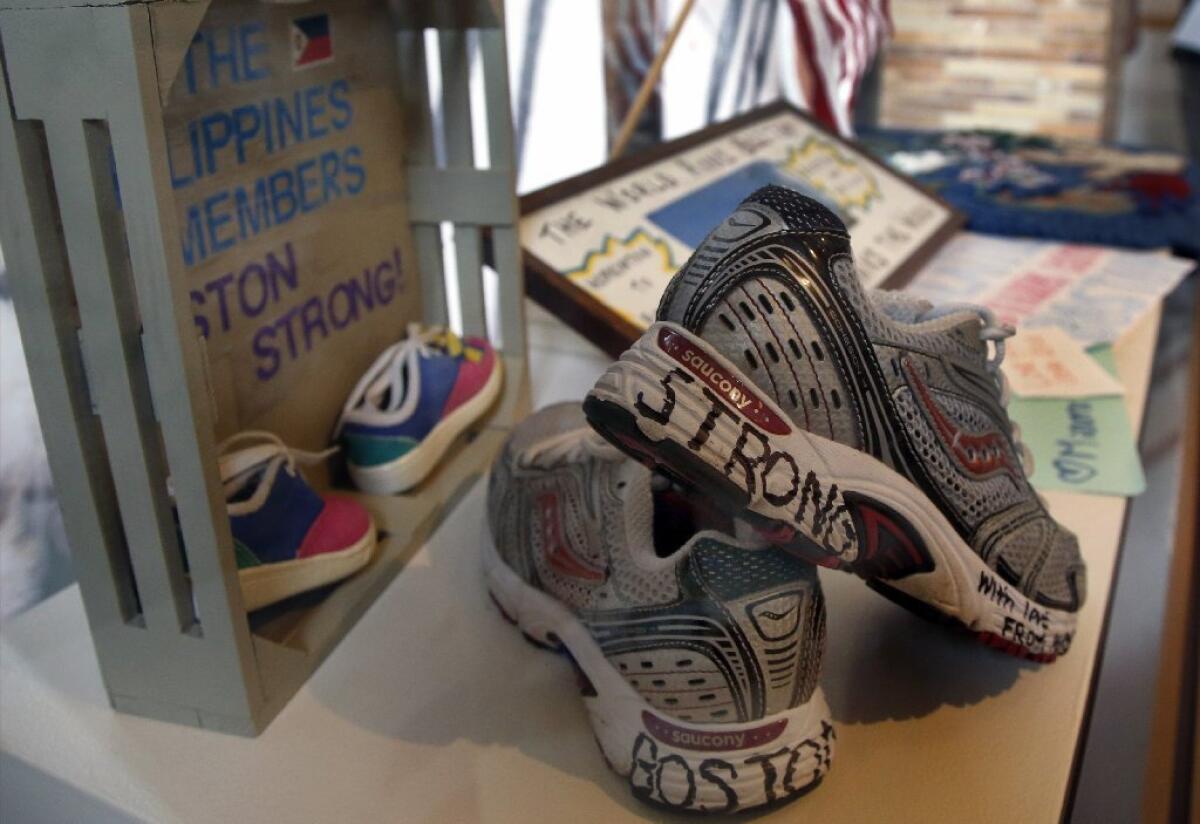The boundaries of Boston Strong

- Share via
The 118th Boston Marathon, next week, will actually be the first of its kind — the first running of the iconic American foot race after two bombers killed three people, injured 263 (many horribly) and shook the nation a year ago Tuesday.
A race that had long since settled into familiar ritual was suddenly fraught. Security, high last year, will be doubled this year. Nine thousand additional participants are expected, along with 1 million spectators, twice the usual number. Media coverage, never shabby for the event, will multiply. It won’t be just Runner’s World poised to record the winners at the finish line, it will be all the world, and who wins won’t be the half of it.
The buildup began weeks ago. Boston radio is playing “Why we run” stories — “This year it’s for, you know, greater reasons,” Juli Windsor told NPR. “60 Minutes” unfolded a “now it can be told” report on the manhunt for the Tsarnaev brothers. Sports Illustrated invited all of Boston to a commemorative-cover shoot on Saturday. And at a ceremony timed for one year after the first bomb exploded, a moment of silence will be observed.
If you miss all that, you can catch the montage of security cam, phone cam and professional cam highlights that will be played and replayed in the coming days: The popping sounds, the shouts, the black hat and the white hat, the Good Samaritans, the murdered MIT police officer, the Watertown shootout, the bleeding boy in the backyard boat.
When America gets outraged, we communicate it. When we are attacked, the furies descend. We make noise, we want answers, we demand action. Last year, we were riveted for days by real-time reporting and vigilante rumors, impatient for results. We chased down the details of an immigrant family, divined if not solved the mystery of “why.” Lives were saved and heroes anointed. Flowers, flags and running shoes piled up in Copley Square. We watched the funeral processions, followed the survivors’ progress. We were — we are — flamboyantly, defiantly Boston Strong.
But here is something we may have missed along the way: On April 14, the day before the marathon, at least 20 people were killed as Al Shabab jihadists caromed through Mogadishu, Somalia. And hours before the marathon on April 15, Iraq was wracked by multiple car bombs — at least 30 dead, as many as 350 injured by some reports, all on just one violent day in a record year of mayhem there.
Such events are the raw material of daily news organizations and even of Op-Ed editors — these distant tragedies were not ignored by U.S. media. But did you remember them? Will CNN or Fox or your newspaper offer updates this week, will they cover the anniversary? In Somalia, did the furies descend? In Baghdad, were the masterminds met by investigators prepared to chase them to the ends of the Earth? How far have the wheels of justice turned in these nations? Can any of the maimed dance, or run, again?
Surely those touched by the violence in these cities will commemorate the carnage. But it is safe to say there isn’t a big market for Iraq Strong rubber bracelets in Baghdad or for Mogadishu Strong T-shirts in Somalia. Maybe someday.
The generals prepare us for asymmetrical warfare. But the deeper asymmetry is a world divided into nations and cities that have — or don’t — the wherewithal to mend the holes that get blown in the social fabric. We live where the rule of law demands action, where citizens have the luxury of insisting that attention must be paid; elsewhere, resilience is measured with little fanfare.
It is right and good this week to remember the tragedy in Boston, to mourn the losses, commemorate the heroes, celebrate the way so many have done so much so quickly to stitch up what was blown apart on Boylston Street last year. Boston Strong indeed. But don’t forget about Mogadishu and Baghdad, and everywhere else bombs burst in the air.
Susan Brenneman is the deputy Op-Ed editor of The Times.
A cure for the common opinion
Get thought-provoking perspectives with our weekly newsletter.
You may occasionally receive promotional content from the Los Angeles Times.








